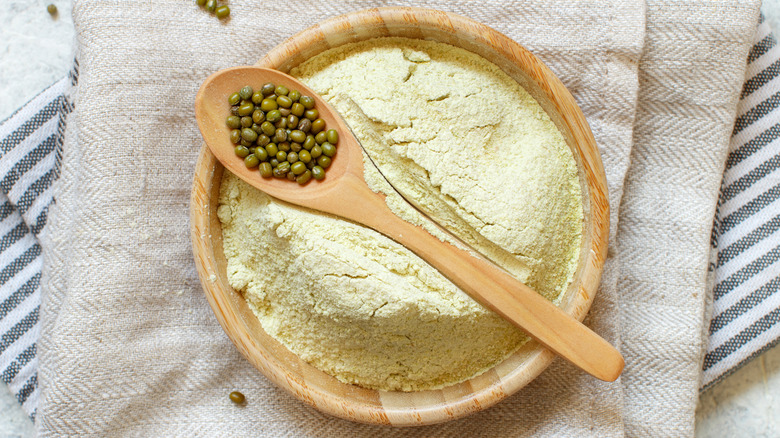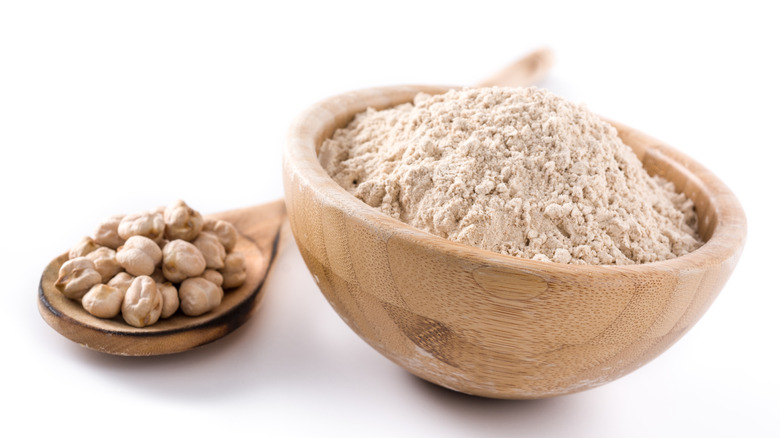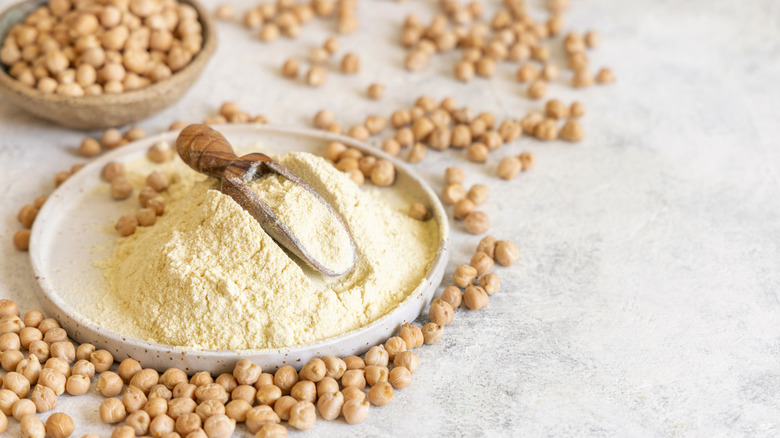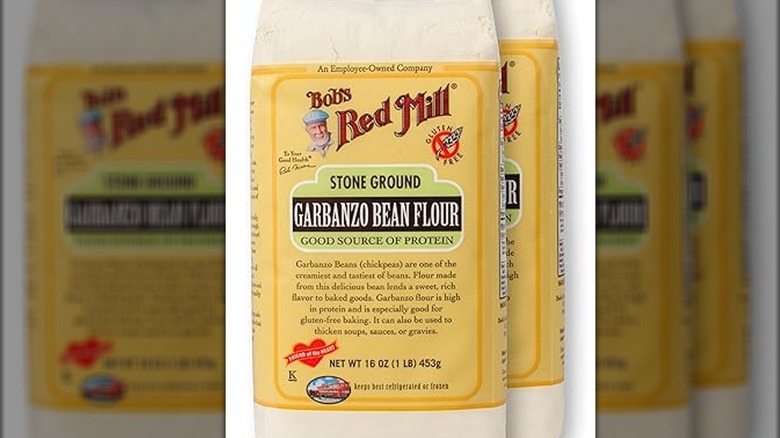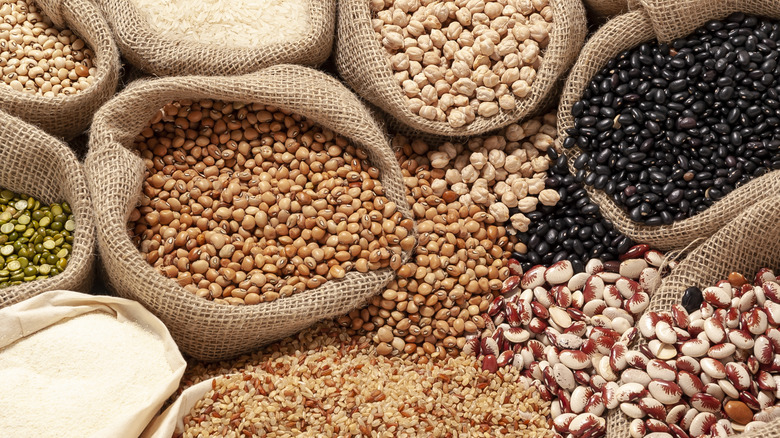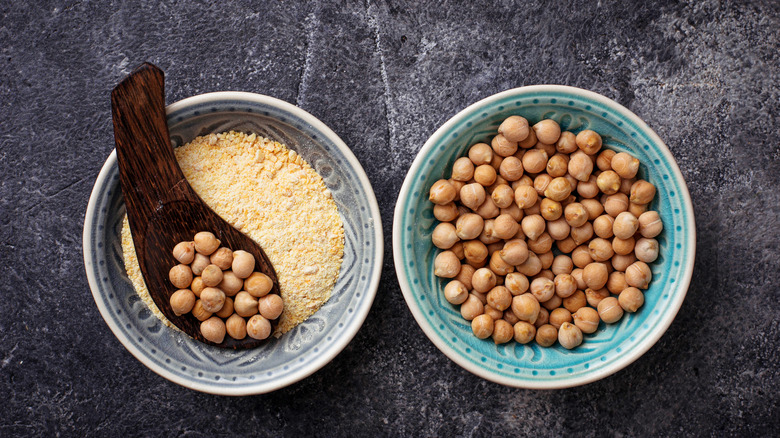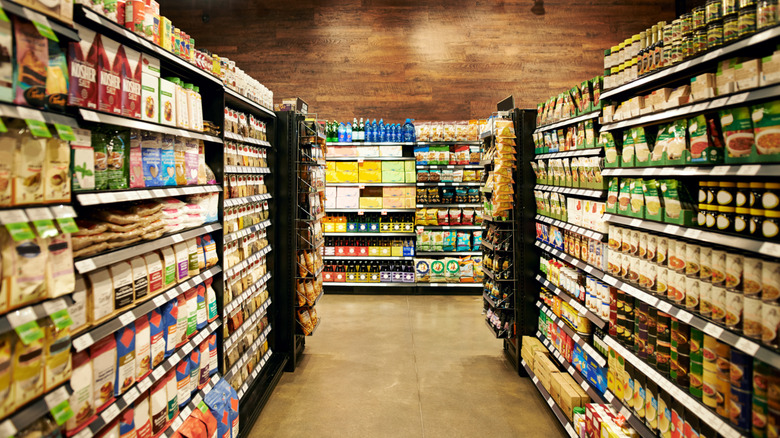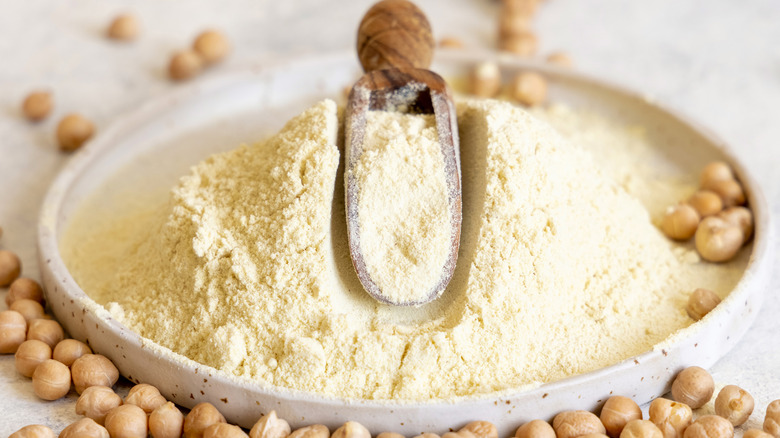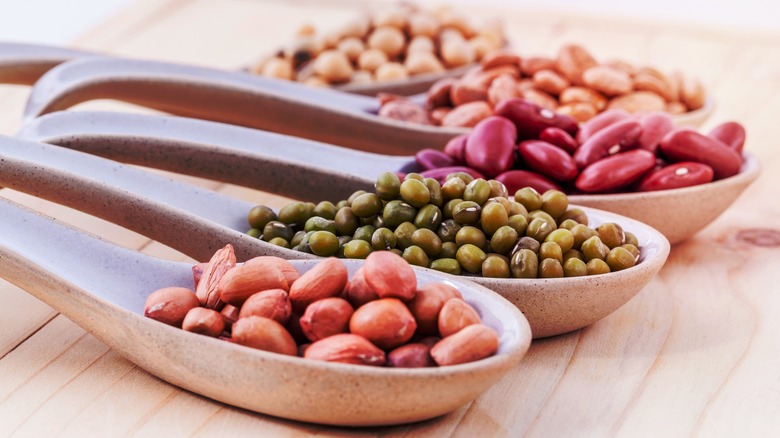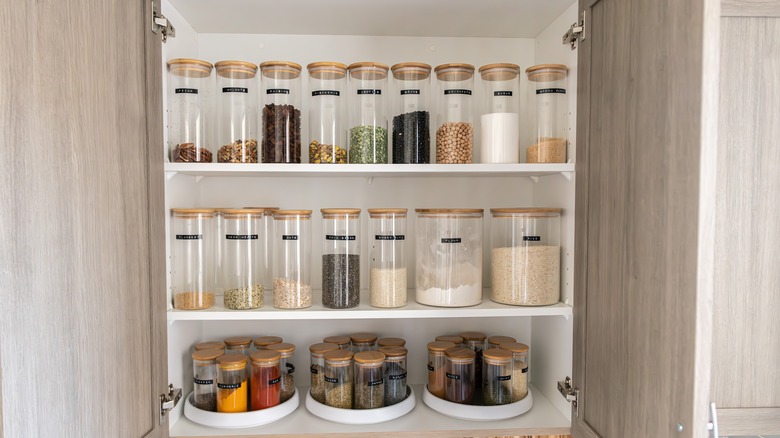What Is Bean Flour And How Is It Best Used In Cooking?
We may receive a commission on purchases made from links.
As more home cooks search for gluten-free alternatives to essential ingredients in both cooking and baking, bean flour exists as a nutrient-rich, high-protein powder that can build up and flavor dishes of all sorts. This one-ingredient specialty product comes in as many varieties as there are beans, and as a very convenient option, you're likely to find that bean flour is becoming more abundant on your local grocery store shelves.
Besides its ample health benefits, from antioxidants to plant-based protein, bean flour is an attractive option because of its variety and simplicity. From chickpea flour to black bean flour, and pretty much everything in between, this versatile ingredient stands at the ready to give your dishes a generous boost of nutrients and flavor. While you can make bean flour yourself at home, there are important considerations when preparing raw beans that you must keep in mind in order to stay safe. However, with a bit of time, attention, and effort, you'll have the pleasure of grinding up a bountiful supply of bean flour, ready to enhance your recipes in a variety of ways.
What is bean flour?
According to the Harvard School of Public Health, beans come from the "Fabaceae or Leguminosae family" and can also be categorized as legumes and pulses. Bean flour is a finely ground powder that appears in a variety of colors depending on the type of beans used to make it. This name is given to any of the end products regardless of what kind of beans are used. Many bean flours are beige, but garbanzo bean flour, for example, appears more yellow while black bean flour is generally a much darker brown. Grinding beans is not a new practice. According to Healthline, chickpea flour for example is a longstanding ingredient in Indian cuisine. Still, bean flour is seeing increased popularity and with that a heightened amount of commercial availability. Bean flour can enhance your recipes, whether savory or sweet, and provide an excellent, gluten-free alternative to all-purpose flour or cornstarch. Additionally, these flours will add fiber, protein, and a host of nutrients to your dishes whether soups and stews or baked goods.
How is bean flour made?
Though store-bought bean flour offers convenience, it can be made at home in just a few simple steps. Depending on the purpose of your homemade bean flour and the flavor profile of the dish you'll be using it for, selecting the right type of bean should be given adequate consideration before you begin processing.
Many choose to simply grind up the dry, raw beans as Vitamix suggests, as a quick way to make flour. Alternatively, some homemade bean flour makers choose to soak their beans in water for anywhere from a few minutes to overnight before processing. This extra step helps to remove impurities from the beans and also reduces the gastrointestinal distress that eating beans can cause. If you go the soaking route, you'll also have to fully dry your beans before grinding them. This can be done in your oven over low heat, but beans can also be air-dried. Allowing the beans to dry before grinding them prevents excess moisture from getting into the flour, which could cause clumping and uneven grinding.
Finally, using a high-powered blender you can grind your dry beans into fine flour. Some recipes call for sifting the freshly ground flour for an extra fine consistency but this is an optional step. Additionally, home cooks can choose to toast the finished flour in the oven to produce a more neutral-tasting final product.
Homemade Bean Flour vs. Store-bought Bean Flour
Both homemade bean flour and store-bought bean flour are interchangeably used in cooking. And they are both made from the simple process of grinding up dried beans. Making bean flour at home is generally much more cost-effective than purchasing it from the store. However, store-bought bean flour may offer a wider selection when it comes to harder-to-find beans, such as mung beans. Additionally, the store-bought varieties also offer an added layer of security when it comes to avoiding the harmful proteins that certain beans are especially high in.
According to Utah State University, some raw and undercooked beans, especially kidney beans, have high levels of an "antinutrient" called phytohemagglutinin (PHA). PHA is a protein found in legumes that even in small amounts can cause severe foodborne illness. Black beans and white kidney beans also have high levels of PHA, but red kidney beans specifically pose a more serious gastrointestinal risk and should be avoided completely when undercooked and raw.
Once beans are adequately cooked, PHA is broken down and no longer poses a threat. Soaking beans before grinding can also reduce the amount of PHA in the beans. The inherent risk may be a good reason to avoid making certain types of bean flour at home. In these situations, it's generally best to err on the side of caution and leave the manufacturing to professionals whose processing is held to specific safety standards.
What does bean flour taste like?
Bean flour can vary in taste based on the type of beans used to make it. Compared to All-Purpose flour, bean flour has a more prominent taste, but that taste can serve as an advantage when it is added to savory recipes that can benefit from its depth of flavor. Some varieties, such as white bean flour, deliver a very mild taste, which makes it more versatile for a wider range of uses. These milder-tasting bean flours can easily be included in everything from savory dips to sweet baked goods, replacing either the all-purpose flour or cornstarch that a recipe calls for. On the other hand, varieties of bean flour, such as fava bean flour, have a stronger flavor with earthy undertones. In these cases, it may be best to avoid using the flours for sweet recipes and instead include them only in bold, savory dishes.
Additionally, you might find that the raw flavor of bean flour is quite different than when it is cooked. When raw, chickpea flour has a very bitter taste that transforms during cooking into a light and pleasant flavor. Trying out different varieties of bean flour and experimenting with them in various dishes is the best way to discover your preferences.
How to cook with bean flour
Bean flour can be used in cooking in many ways that traditional white flour is used. Just as with traditional wheat flour, eating bean flour raw is not advised. This is due to the taste and high amount of phytic acid in uncooked beans, according to WebMD. The major differences between wheat flour and bean flour are that bean flour is gluten-free and flavored, and you'll generally need to use less of it than you would regular flour. You'll also likely need to use binders such as xanthan gum when swapping in bean flour because it does not hold together the way that gluten-rich flour does. You can whisk bean flour into your soups and sauces to thicken them and add flavor, and you can even include them in your sweet baked goods for an added boost of protein and fiber.
Bean flour can be used for baking bread, breakfast muffins, and even black bean brownies. It's important to note, however, that bean flour is not to be substituted at a 1:1 ratio as a direct replacement for all-purpose flour. It absorbs liquid differently than traditional wheat flour and can lead to overly dense and dry final products if not properly substituted into a recipe. Using trusted, well-developed recipes, and experimenting on your own, will lead to the best long-term results.
Where to buy bean flour
If you are making bean flour at home, always start with high-quality beans. Be sure to sift through your beans to remove any debris and to look for any signs of damage or discoloration.
When buying bean flour, it's important to ensure the packaging is airtight and to check the expiration date before purchase. When opening the bean flour, it should have a mild smell and a uniform appearance. It should be powdery and not appear to have lumps or discoloration.
You can find bean flour in the baking aisle of many grocery stores. Though it continues to grow in popularity, the area that you live in could still mean you have a limited selection locally available to you. Chickpea flour (also known as Garbanzo Bean Flour), Lupin Flour, and Fava Bean Flour are often the easiest to find in stores due to their widespread appeal and usefulness in recipes.
Bob's Red Mill is a popular brand that has some bean flour available in stores, and previously offered an even larger selection, of unique items such as black bean flour, online. If you're having trouble finding a particular bean flour, you might check a local international market, as the product you're looking for might be one that's more widely used outside of the United States. Additionally, you can find many varieties available through large online retailers such as Amazon.
Nutritional information about bean flour
Because there are so many different kinds of bean flour, it's difficult to generally describe its nutritional information. However, beans are recognized as a superfood and are therefore considered to be very healthy across the board. According to Future Market Insights, bean flour contains a wide range of vitamins, minerals, and nutrients that assist in everything from reducing the risk of heart disease to regulating the bacteria in your gut biome. Additionally, beans are high in protein, which can help maintain healthy muscles and boost energy levels, and they're also high in fiber, which contributes to a healthy digestive system.
According to Healthline, chickpea flour is found to be lower in carbs and calories when compared to all-purpose flour, all while appearing to be more filling than its wheat counterpart. These findings suggest that bean flour can be a wonderfully healthy option with possible long-term positive effects on those who incorporate some type of this versatile ingredient into their diets.
Varieties of bean flour
There are many varieties of bean flour. Black beans, fava beans, pinto beans, chickpeas, and mung beans are all among some of the more popular types of beans that are ground for this purpose. Each of these varieties has its own colors and flavors, making each variety ideal for different kinds of recipes. In some cases, people choose to enjoy bean flour made from raw beans while others exercise a bit more caution and only consume flour from beans that were cooked before processing. The distinction between raw and cooked can also impact the color and flavor of the flour.
Some bean flours offer a milder taste that is suitable for baking sweet recipes while others have a more prominent taste that is ideal for savory recipes that may already be heavy on bean flavor. There are also mixed varieties of bean flours commercially available that have been blended for the ideal combination of texture, taste, and nutritional content.
How to store bean flour
In order to keep it fresh for as long as possible, it's important to properly store your bean flour. It is best to take it out of the package that it came in and place it into a suitable container that can block out humidity, withstand normal fluctuations in temperature, and keep pests out. If you cook with bean flour often, store it in an airtight container that is kept in a cool, dry place at room temperature and away from direct sunlight. Just as with wheat flour, bean flour can absorb excess moisture and spoil when not properly closed. In the pantry, bean flour can last about 6 months. However, if you don't cook with it too frequently, you might find storing it in an airtight container in your refrigerator to be a more suitable option. By doing so, you can extend the shelf life of your bean flour up to one year.
